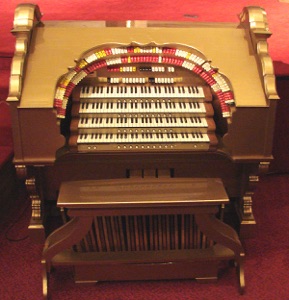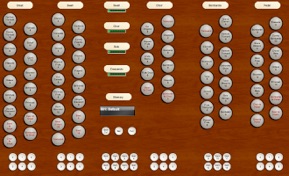

A Complete Virtual Pipe Organ


If you have an analog or pipe organ console, you can have an organ using sampled pipe organ ranks that is equivalent to any of the digital organs in the market place. AND, at a fraction of the cost!
PRESENTING: A TURNKEY VIRTUAL PIPE ORGAN
The following discussion relates to a turnkey virtual pipe organ. In this context, it refers to the fact that everything necessary for operation is provided, except for the cabling from contact closure keyboards to the Input Boards on the panel. If MIDI keyboards and pedalboard are used, it becomes a total turnkey system. Just connect the modules per the instructions ------ and play your new digital organ!
WHAT DO YOU NEED?
All you need is a 2-manual or 3-manual console that has workable keyboards and pedalboard. The stop actions become irrelevant since they are displayed on the Monitor.
If the organ console being used is from an electronic organ that has a basic audio system, that may be adequate.
WHAT DO YOU GET?
The Turnkey Virtual Pipe Organ systems shown here include all of the elements needed to complete a playable theater or classic organ in a 2-manual or 3-manual console shell with keyboards and pedalboard.
It starts with the Artisan Micro-MIDI Control System already mounted on a panel to be installed in the physical console.
The existing keyboards, pedalboard and pistons (presets) are then connected to the Input Boards on this panel. This will achieve MIDI data as an output that is then connected to the computer containing the Sound Engine and Display.
Also, Swell and Crescendo inputs are connected to a junction box that feeds into the analog input of the Micro-MIDI Board which are then converted to MIDI Controller data to join with the Note ON/OFF data from the keyboards and pistons. [ See photo and block diagram, below.]


An added feature is the use of a “splitter” Micro-MIDI Board to enable the user to add a sequencer for Record/Playback, or to add other MIDI devices.
Alternatively, MIDI keyboards and pedalboard can be installed in the console, or simply rack mounted by themselves. If a pedalboard is involved that does not have a MIDI output (as most of them don’t), the µMIDI Control System can do the conversion and blend the data in with the MIDI keyboards for a composite output.
Three and Four manual organ consoles can be implemented with the addition of more hardware added to the Artisan Micro-MIDI Control System panel to accommodate the added keyboards. And, of course, a larger Sample Set to correspond to the added divisions and stops.
The current platform for the Artisan Sound Engine application is a compact, Linux based Operating System using Ubuntu. Linux was selected because it can be installed cleanly to an otherwise empty hard drive, thus not being encumbered by any background programs. Also, Linux is memory efficient, such that a computer does not require large amounts of RAM to contain both the Operating System and the Digital Sampled Voice Ranks. Other platforms may be offered in the future.
WHAT ELSE IS NEEDED?
The second element to complete the Turnkey Virtual Pipe Organ is a Sound Engine and Display. These two items go together since the organ stop list being displayed corresponds to the Sample Set of Digital Pipe Ranks placed in the Sound Engine.
The Monitor screen displays the stops, as well as the pistons, thus stop actions are not required on the console, although they are optional. Instead, all that is required is a number of pistons [up to 32 are available for the 2-manual version] mounted on the console. This allows the Micro-MIDI Control System to act remotely so that the combination action of the Virtual Organ can be controlled from the console. Other than the initial setup, no touch screen or mouse is required to select registrations ---- although either is optional.
The Monitor screen can be set up for any specific theater or classical organ model, (e.g. the various Wurlitzer or E. M. Skinner organs), or it can be altered to conform to any stop list developed by the user. Along with the establishment of any desired stop list for the display, a corresponding group of voices can be included in the Sound Engine. This becomes the Sample Set for that specification.




The current platform for the Artisan Sound Engine application is a compact, Linux based Operating System using Ubuntu. Linux was selected because it can be installed cleanly to an otherwise empty hard drive, thus not being encumbered by any background programs. Also, Linux is memory efficient, such that a computer does not require large amounts of RAM to contain both the Operating System and the Digital Sampled Voice Ranks. Other platforms may be offered in the future.
SUMMARY
The Turnkey Virtual Pipe Organ packages containing variations of the above come complete with detailed instructions for the minimal interconnections required.
The entire system is assembled and pre-tested. The Operating System, the Software Sound Engine and the required Digitally Sampled Voices are installed in the PC.
The Digital Ranks are voiced and regulated to levels normally ascribed to theater or classic organs in general. Once in the local environment, there may need to be adjustments made to conform to the room acoustics, or to the listenable tastes of the user. Adjustments such as individual note tuning and level, overall rank levels, tremulant* depth and speed are available to the end user by changes that can be made to the Software Sound Engine definition.
*Tremulant adjustments do not apply to those ranks where the digitally sampled tremmed ranks are installed. These ranks are the Tibia, Vox, Tuba Horn, Oboe Horn, and Sax.
The initial “canned” Sample Sets will include special versions of the Wurlitzer Style D, the Wurlitzer 216, the Wurlitzer 260 special. Also included will be a small classical practice organ, and a medium sized classical organ suitable for practice or church installation.
Others will be added, or can be customized to suit the customer. It is quite easy to create a Stop List and then match it with the Digital Voice Ranks-----either by Artisan, or by the customer.
This brief video explains the system and gives a small demo of the Artisan Style “D”
As an added feature, the Artisan Micro-MIDI Control System will also interface with other VTPOs such as Miditzer, Hauptwerk, J-Organ, or MyOrgan.
Click on one of the following links for details and pricing
E-Mail us for more info on TurnKey Systems (Click here)
Gee Dad, it’s a Wurli --- it’s a WHAT????







